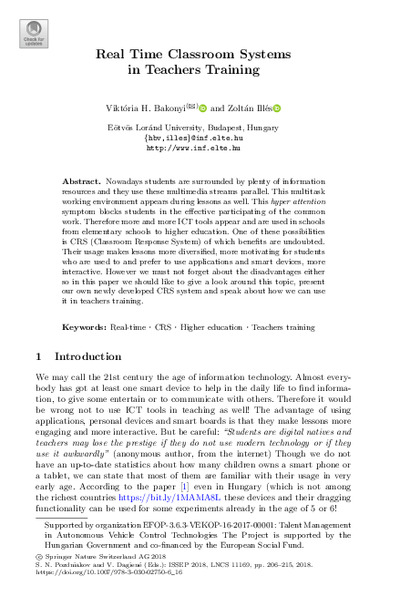Real Time Classroom Systems in Teachers TrainingViktória H. Bakonyi, Zoltán Illés
Zu finden in: Informatics in Schools: Fundamentals of Computer Science and Software Engineering (Seite 206 bis 215), 2018
  |
 |
 Diese Seite wurde seit 3 Jahren inhaltlich nicht mehr aktualisiert.
Unter Umständen ist sie nicht mehr aktuell.
Diese Seite wurde seit 3 Jahren inhaltlich nicht mehr aktualisiert.
Unter Umständen ist sie nicht mehr aktuell.
 Zusammenfassungen
Zusammenfassungen
 Nowadays students are surrounded by plenty of information resources and they use these multimedia streams parallel. This multitask working environment appears during lessons as well. This hyper attention symptom blocks students in the effective participating of the common work. Therefore more and more ICT tools appear and are used in schools from elementary schools to higher education. One of these possibilities is CRS (Classroom Response System) of which benefits are undoubted. Their usage makes lessons more diversified, more motivating for students who are used to and prefer to use applications and smart devices, more interactive. However we must not forget about the disadvantages either so in this paper we should like to give a look around this topic, present our own newly developed CRS system and speak about how we can use it in teachers training.
Nowadays students are surrounded by plenty of information resources and they use these multimedia streams parallel. This multitask working environment appears during lessons as well. This hyper attention symptom blocks students in the effective participating of the common work. Therefore more and more ICT tools appear and are used in schools from elementary schools to higher education. One of these possibilities is CRS (Classroom Response System) of which benefits are undoubted. Their usage makes lessons more diversified, more motivating for students who are used to and prefer to use applications and smart devices, more interactive. However we must not forget about the disadvantages either so in this paper we should like to give a look around this topic, present our own newly developed CRS system and speak about how we can use it in teachers training. Dieser wissenschaftliche Zeitschriftenartikel erwähnt ...
Dieser wissenschaftliche Zeitschriftenartikel erwähnt ...
 Begriffe KB IB clear | Classroom response systemClassroom response system
,  LehrerIn LehrerIn teacher
, LehrerInnen-Bildungteacher training teacher
, LehrerInnen-Bildungteacher training
|
 Dieser wissenschaftliche Zeitschriftenartikel erwähnt vermutlich nicht ...
Dieser wissenschaftliche Zeitschriftenartikel erwähnt vermutlich nicht ... 
 Nicht erwähnte Begriffe | Schule, Unterricht |
 Tagcloud
Tagcloud
 Anderswo finden
Anderswo finden
 Volltext dieses Dokuments
Volltext dieses Dokuments
 |  Real Time Classroom Systems in Teachers Training: Artikel als Volltext @ Springer ( Real Time Classroom Systems in Teachers Training: Artikel als Volltext @ Springer ( : :  , 1913 kByte; , 1913 kByte;  : :  ) ) |
 Anderswo suchen
Anderswo suchen 
 Beat und dieser wissenschaftliche Zeitschriftenartikel
Beat und dieser wissenschaftliche Zeitschriftenartikel
Beat hat Dieser wissenschaftliche Zeitschriftenartikel während seiner Zeit am Institut für Medien und Schule (IMS) ins Biblionetz aufgenommen. Er hat Dieser wissenschaftliche Zeitschriftenartikel einmalig erfasst und bisher nicht mehr bearbeitet. Beat besitzt kein physisches, aber ein digitales Exemplar. Eine digitale Version ist auf dem Internet verfügbar (s.o.). Aufgrund der wenigen Einträge im Biblionetz scheint er es nicht wirklich gelesen zu haben. Es gibt bisher auch nur wenige Objekte im Biblionetz, die dieses Werk zitieren.










 Biblionetz-History
Biblionetz-History